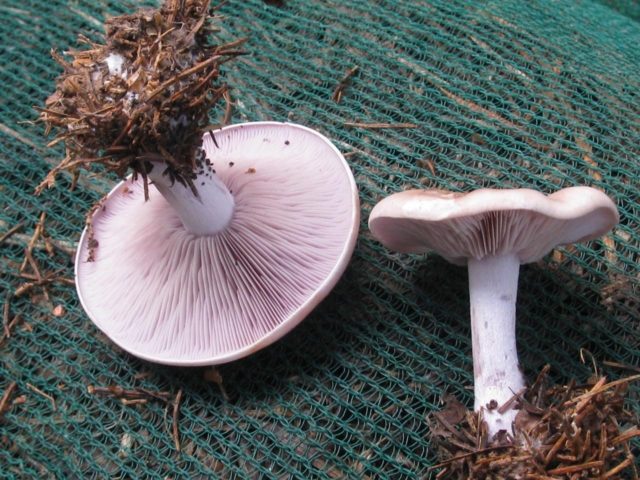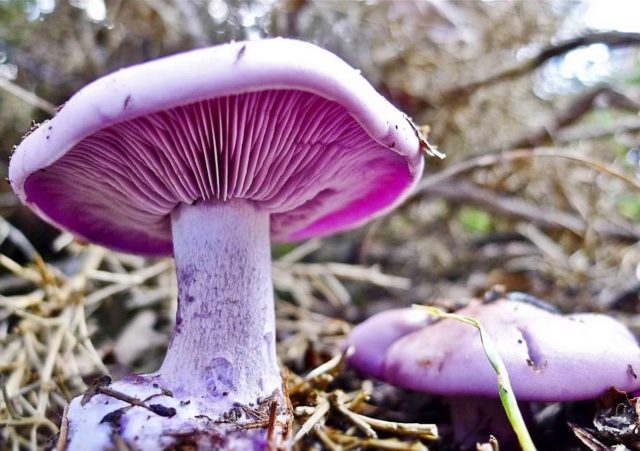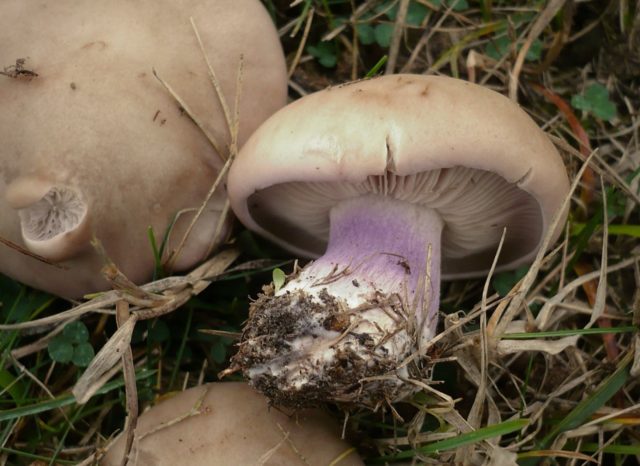Content
Row grayish-lilac or ryadovka gray-blue is a mushroom of the genus Lepista, known under several Latin names: Clitocybe glaucocana, Rhodopaxillus glaucocanus, Tricholoma glaucocanum. The species is classified as conditionally edible. The color of the fruit body darkens after precipitation, the structure becomes hygrophilous.
Where do the rows grow grayish-lilac
Row grayish-lilac is not common, it prefers places on a thick layer of leaves or needles. Selects light, fertile, well-aerated soils with moderate moisture. The mycelium is located close to the surface of the soil, therefore, the accumulation of the species can often be found in the thickets of nettles, among low-growing shrubs. For full-fledged fruiting, a constant air temperature, partial shade and moderate humidity are required.
It settles not only in dense forests, but also in tall grass along the banks of rivers and reservoirs. Less common on the sides of forest roads and paths. The main condition required for growth is a thick layer of leaf or coniferous cushion. Fruiting in early autumn, forms numerous colonies arranged in rows or half rings. The main distribution area in Russia is the Urals, Siberia and the Central part. Less common in the Leningrad and Moscow regions.
What do the rows look like grayish lilac
The peculiarities of the species include the variability of the color of the fruit body, depending on the age and level of seasonal precipitation. At low humidity, the color is pale, gray-blue, in young specimens it is smoky. After rain, the mushroom accumulates moisture, becomes a dark purple or lilac hue.
External description of the rowing grayish-lilac:
- the mushroom is small in size, the average diameter of the cap in a mature specimen is 15 cm, less often a little more;
- the shape at the beginning of growth is cylindrical with a bulge in the center; over time, the cap opens and becomes flat with a depression in the middle;
- edges are uneven, wavy or lobed, concave;
- the surface is smooth, velvety in dry weather, slippery, oily during rains;
- the flesh is white, dense, thick, becomes friable and brittle during rains;
- the plates are densely located, at the base of the cap are observed rudimentary, reaching the middle;
- plates are long, fixed tightly with wavy edges, there is no clear border at the transition to the stem;
- the color of the lamellar layer is violet, gray or lilac, more saturated than the upper part of the cap.
The leg grows up to 8 cm, of medium thickness. Central, cylindrical, one-piece. The structure is fibrous, clavate in the lower part, with an attached light lilac mycelium. Surface with fine flakes.The color is monochromatic, matching the color of the plates or a tone lighter.
Is it possible to eat rows of grayish-lilac
The species belongs to the conditionally edible group. There are no toxins in the chemical composition. Fruit bodies are suitable for any method of preparation and processing.
It is completely destroyed after boiling. Therefore, a grayish-lilac row is used only after heat treatment.
Taste qualities of ryadovka mushroom grayish-lilac
The fruit body has a dense pulp with a sweetish taste. The grayish-lilac ryadovka has a pleasant floral scent.
The prepared dishes fully preserve the taste of the mushroom. After processing, the smell is present, but it does not appear as intense as in raw specimens.
Benefits and harm to the body
The mushroom contains vitamins, trace elements, amino acids. The ryadovka protein is not inferior in composition to animal protein, fats and carbohydrates are present in insignificant quantities, which ensures a low calorie content of the product. The consumption of mushrooms enriches the body with substances necessary for normal functioning, without leading to the accumulation of excess weight.
Useful qualities of a grayish-lilac row:
- improves digestion processes;
- enriches the blood with iron;
- participates in the work of the endocrine system;
- restores liver cells;
- improves brain activity, strengthens the immune system.
Harm from rowing:
- in case of individual intolerance, it causes an allergic reaction.
- cannot be used without preliminary heat treatment;
- not recommended for people with gastritis, pregnant and lactating women.
False doubles
The species has no inedible counterparts. Outwardly, a gray-blue ryadovka looks like a purple ryadovka.
The nutritional value of the species is the same. The places of distribution and the time of fruiting are the same. The twin has a brighter purple color of the spore-bearing layer, the leg with lilac fragments. The pulp is laced with purple fibers.
The lilac-footed row is an edible mushroom with a longer fruiting period. The first colonies appear in early summer, growth resumes after precipitation, and collection continues until the end of September.
Grows in pastures, forest glades, near water bodies. Does not occur in dense thickets. The twin is distinguished by a beige or light brown hat and a blue leg.
Collection rules
Do not collect old specimens, since toxic compounds are released during the decomposition of protein, fruit bodies can cause poisoning. Grayish-lilac rows damaged by insects or slugs do not go for processing. It is not recommended to harvest in an unfavorable ecological zone near industrial enterprises, landfills, federal highways. Fungi accumulate harmful substances from the atmosphere and soil, and can cause intoxication.
Use
Row grayish-lilac is a rare species. It grows every year in the same place. After processing, mushrooms can be fried, used for making soup, stewed with vegetables. Suitable for salting, pickling, freezing. Fruit bodies are not used for harvesting in dried form.
Conclusion
Row grayish-lilac - conditionally edible mushroom, universal purpose. Grows in groups on a leafy or coniferous litter. Fruiting in late summer, found among dense bushes, nettle thickets on fertile soil with moderate moisture.












